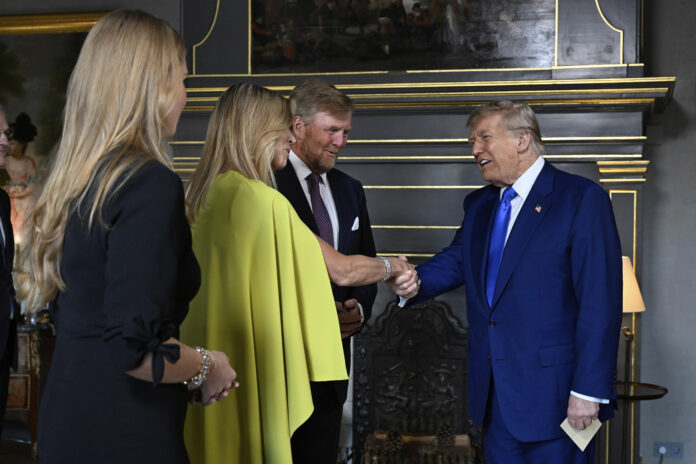- Donald Trump’s vague stance on NATO’s mutual defense clause unsettles European allies at the summit.
- NATO members agree to increase defense spending to 5% of GDP by 2035 to deter Russia and keep U.S. support.
- Deep divisions remain over Ukraine’s role and future NATO membership amid ongoing conflict and shifting U.S. policies.
With his usual flair, Donald Trump made a thunderous entrance at the NATO summit in The Hague on Tuesday, June 24. The U.S. president, now seeking a dramatic return to power, joined leaders from NATO’s 31 member nations for a formal dinner hosted by Dutch King Willem-Alexander at the opulent Orange Hall. But instead of unity and assurance, Trump brought with him a storm of doubt—one that cast a long shadow over the two-day gathering.
European leaders hoped this summit would cement renewed commitments to defense spending and show solidarity against external threats, particularly from Russia. But Trump’s remarks did little to calm nerves. Instead of reaffirming America’s ironclad commitment to Article Five—the cornerstone of NATO’s mutual defense pact—he offered only vague reassurances.
“It depends on your definition,” Trump said aboard Air Force One when asked about Article Five. “I’m committed to being their friend.”
Those words hit hard across European capitals, where leaders have grown wary of Trump’s ambivalence toward traditional alliances. To many, “friendship” isn’t enough when missiles are flying and tanks are rumbling across borders.
NATO Scrambles to Keep Trump Onside
Behind the scenes, frantic negotiations had already taken place to try and keep Trump engaged. NATO crafted a plan to boost defense spending, promising to channel 3.5% of each member’s GDP into military capabilities by 2035, and an additional 1.5% toward broader security investments like cybersecurity and infrastructure. The goal? Reach a symbolic and strategic 5%—a number Trump himself had floated.
Trump praised the move. “They’re going to be lifting it to 5%, that’s good,” he said. “It gives them much more power.”
But it’s clear this wasn’t just about power. The alliance desperately needs to keep Trump feeling influential and respected—especially amid reports from Washington that the U.S. might pivot its military focus from Europe to China if NATO doesn’t step up.
A Fragile Alliance Under Pressure
The heart of the division, though, remains the war in Ukraine. Trump’s attitude toward the conflict has drastically shifted since his return to the political stage. Unlike the strong backing seen under President Biden, Trump has distanced himself from Kyiv and spoken more openly about improving ties with Moscow.
Ukrainian President Volodymyr Zelensky, once a central figure at NATO events, found himself largely sidelined this time. He wasn’t even invited to the main working session. Instead, his team confirmed he would attempt a brief meeting with Trump, hoping to secure a package of air defense systems and discuss tougher sanctions on Russia.
“There’s no indication that Putin wants peace,” Zelensky told a defense forum that ran parallel to the summit. “Russia rejects every proposal—even those from the U.S. Putin is only thinking about war.”
Trump, meanwhile, did take time to chat privately with Turkish President Recep Tayyip Erdogan. Erdogan, playing the role of mediator, encouraged “close dialogue” to end the war. But whether Trump was listening or merely entertaining another round of diplomatic theatre is anyone’s guess.
Defense Spending Promises: Big Words, Bigger Price Tags
NATO’s spending targets sound ambitious, but the burden falls unevenly across the alliance. Germany announced it would hit the 3.5% mark for core military needs by 2029—well ahead of the official 2035 deadline. That move won praise from some quarters and signaled Berlin’s growing willingness to take on more responsibility.
But not all leaders were on board.
Spain’s Prime Minister Pedro Sanchez flatly rejected the idea of spending 5% of GDP on defense, a stance that risks drawing Trump’s ire. The tension between meeting financial expectations and protecting domestic priorities was palpable.
Meanwhile, the UK tried to seize the moment. British Prime Minister Keir Starmer declared that the UK would meet the full target, and revealed plans to purchase a dozen F-35A fighter jets—aircraft capable of delivering nuclear weapons. The deal represents a major upgrade to the UK’s current nuclear deterrent, which relies solely on submarine-launched systems.
Starmer’s office later released a statement quoting NATO Secretary-General Mark Rutte, who welcomed the purchase and called it “yet another robust British contribution to NATO.”
Public Reaction: Fear, Frustration, and Uncertainty
Across Europe, reactions to Trump’s NATO appearance ranged from anxious to outright alarmed. Critics accused the former U.S. leader of undermining decades of carefully built alliances. Social media lit up with concern over what many described as “reckless unpredictability.” In Berlin, French officials privately voiced worries about being left vulnerable if Trump pulls back American support during a crisis.
Others took a more pragmatic view. “If throwing money at the problem is what it takes to keep Trump onside, so be it,” said one senior diplomat from Eastern Europe. “But let’s not pretend this is sustainable.”
Back in the U.S., voters were watching closely too. While Trump’s base cheered his assertiveness and disregard for international bureaucracy, more moderate voices expressed concern that alienating allies could backfire if global tensions spiral out of control.
What Comes Next?
The NATO summit is expected to end without any official endorsement of Ukraine’s bid for membership—a move Trump firmly opposes. For Kyiv, that’s a bitter pill. Zelensky had hoped to leave The Hague with a clearer path forward, not just for aid but for lasting inclusion in the alliance.
NATO leaders will attempt to paper over the cracks by reaffirming support for Ukraine in their final statements. But everyone knows the real question remains unanswered: How committed is Trump to the very alliance he once called “obsolete”?
In the grand dining rooms of The Hague, leaders toasted their unity. But behind closed doors, the mood was anything but celebratory. Trust, once the bedrock of NATO, now feels like it’s hanging by a thread—and Trump is holding the scissors.




